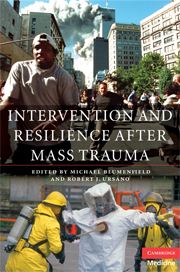Book contents
- Frontmatter
- Contents
- List of contributors
- Foreword by Joseph T. English
- Preface
- 1 Systems, science, and populations: Effective early mental health intervention following mass trauma: the roles of government, clinicians, and communities
- 2 Factors in the development of community resilience to disasters
- 3 Psychological first aid
- 4 Acute stress disorder and early interventions after trauma
- 5 The role of pharmacotherapy in early interventions
- 6 Should culture considerations influence early intervention?
- 7 Resilience is the default: how not to miss it
- 8 Epilog: Early intervention for individuals and communities: planning for the future while meeting present needs
- Index
- References
5 - The role of pharmacotherapy in early interventions
- Frontmatter
- Contents
- List of contributors
- Foreword by Joseph T. English
- Preface
- 1 Systems, science, and populations: Effective early mental health intervention following mass trauma: the roles of government, clinicians, and communities
- 2 Factors in the development of community resilience to disasters
- 3 Psychological first aid
- 4 Acute stress disorder and early interventions after trauma
- 5 The role of pharmacotherapy in early interventions
- 6 Should culture considerations influence early intervention?
- 7 Resilience is the default: how not to miss it
- 8 Epilog: Early intervention for individuals and communities: planning for the future while meeting present needs
- Index
- References
Summary
There is understandable reluctance to utilize pharmacotherapy during the immediate aftermath of exposure to a traumatic event. Although most people will be distressed during the acute post-impact phase, the great majority will recover during the following weeks. As a result, clinicians are hesitant to “pathologize” such normal reactions to traumatic stress by utilizing medications.
It is recognized that a substantial minority of survivors will not recover on their own but will go on to develop a psychiatric disorder such as post-traumatic stress disorder (PTSD), depression, another anxiety disorder, or alcohol/substance misuse. Since PTSD is the most common post-disaster adverse psychiatric consequence, and because what little empirical research that has been published on acute post-traumatic pharmacotherapy has focused on that disorder, I will only discuss early interventions for PTSD. It should be kept in mind, however, that some survivors who never develop PTSD may become symptomatic with a different psychiatric problem.
Ideally, there would be a reliable way to identify the minority of survivors who are at greatest risk of developing PTSD following disasters. Such a reliable method for psychiatric triage would support the argument for early pharmacotherapy as prophylaxis, despite the reluctance to prescribe medications, discussed previously. Several prodromal signs and symptoms have been proposed as predictors of post-disaster PTSD such as acute stress disorder (ASD), elevated heart rate, peritraumatic dissociation, or manifestation of PTSD's A2 criteria (e.g., expression of “fear, helplessness, or horror”) (Friedman et al., 2004; Friedman and Karam, in press).
- Type
- Chapter
- Information
- Intervention and Resilience after Mass Trauma , pp. 107 - 126Publisher: Cambridge University PressPrint publication year: 2000
References
- 1
- Cited by



